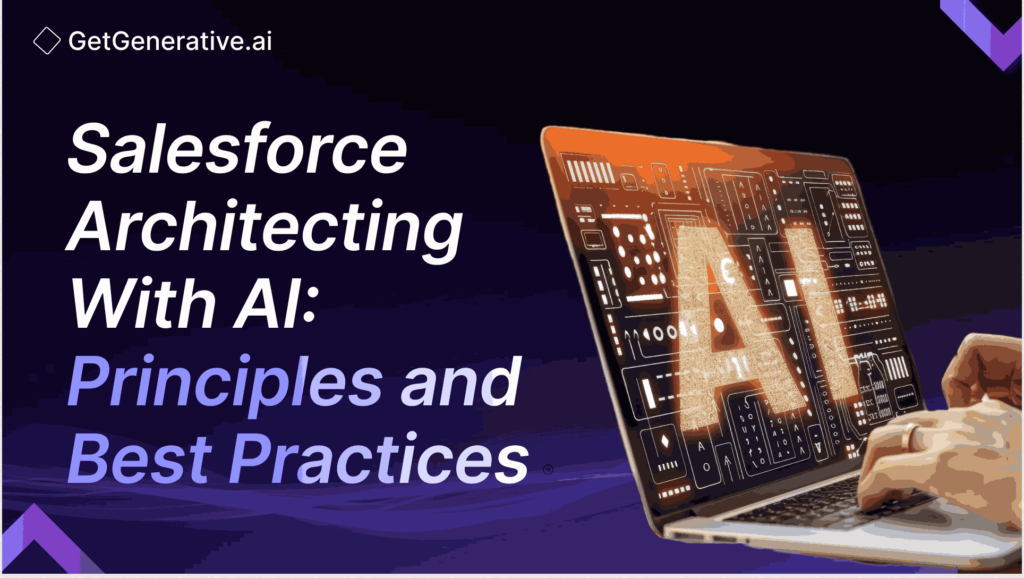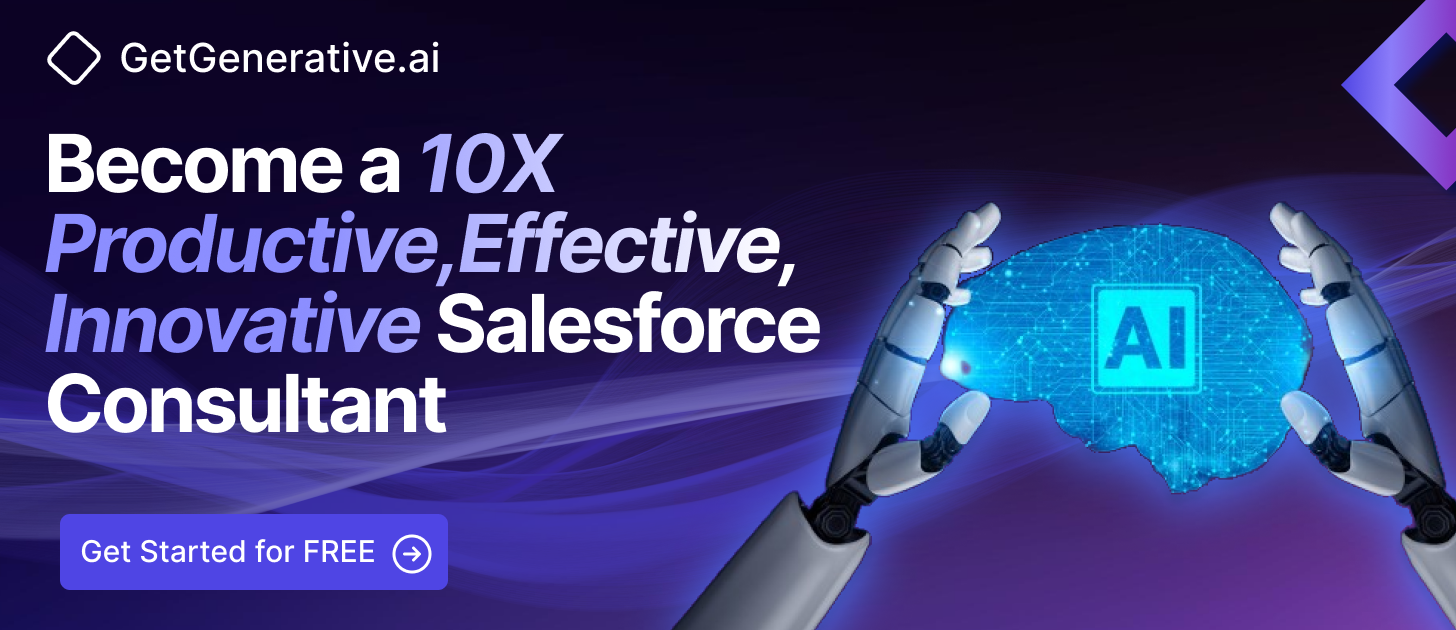Salesforce Architecting With AI: Principles and Best Practices
AI has been a buzzword, and Salesforce has been pioneering in this space since 2014. Today, we’re in the second wave of AI—the generative AI wave. Let’s explore how AI impacts us as architects and how we can harness it effectively in our organizations.
The Core Principles: Trust, Ease, and Adaptability
We focus on trust, ease, and adaptability to build a well-architected AI solution on the Salesforce platform. These principles ensure that your AI solutions are effective, secure, user-friendly, and resilient.
Trust: The Foundation of AI Solutions
Trust is the cornerstone of any successful AI implementation. Without trust, stakeholders will be reluctant to adopt and rely on AI-driven solutions. At Salesforce, we define trusted AI solutions through three key elements: security, reliability, and compliance.
- Security: Protecting data is paramount. AI solutions must be designed to control and safeguard data, ensuring that sensitive information remains secure.
- Reliability: AI systems should operate efficiently and dependably, providing consistent and accurate outputs.
- Compliance: Adherence to legal and ethical guidelines is crucial. As AI evolves, compliance with these guidelines will become increasingly important.
To achieve these goals, Salesforce architects should follow specific patterns and avoid anti-patterns:
Patterns for Building Trusted AI:
- Data Management: Treat your data with the utmost care and respect. Well-organized and well-classified data is the foundation of powerful AI.
- Design Standards: Ensure transparency in your design standards. Reference the data used to generate AI responses and cite your sources.
- Business Process: Implement regular checks to monitor AI performance, ensuring continuous improvement and safety.
Anti-Patterns to Avoid:
- Documentation Issues: AI solutions should align with your business’s purpose. Avoid building AI just because it’s trendy.
- Design Flaws: Ensure your design standards identify AI sources and data.
- Data Confusion: All stakeholders should understand what data goes into AI models and how it’s used.
Also Read – What Is a Salesforce Architect?
Ease: Making AI User-Friendly
Ease of use is critical to the success of AI solutions. Users must engage with AI systems effortlessly, ensuring rapid adoption and effective utilization. Here are some strategies to make AI solutions more user-friendly:
- Intentional Solutions: Deliver business value quickly while considering the long-term impact on customers. AI models should be selected and approved based on their intended business use.
- Automated and Engaging Solutions: Automate tasks to enhance efficiency and create engaging user experiences that delight stakeholders.
Patterns for Ease:
- Clear Disclaimers: Display disclaimers to inform users about AI involvement, empowering them to review AI outputs.
- Empowering Users: Ensure users understand their role in the AI process and can verify AI-generated information.
Anti-Patterns to Avoid:
- Ad-Hoc Model Selection: Avoid using models without thorough evaluation and approval.
- Lack of Transparency: Ensure disclaimers and data sources are clear to users.
- Uninformed Trust: Users should not blindly trust AI outputs; they must be aware of potential inaccuracies.
Adaptability: Evolving with Change
Adaptability is crucial in the dynamic landscape of AI. Solutions must be resilient and composable, capable of adjusting to changes quickly and efficiently. Key aspects of adaptability include:
- Resilient Solutions: Design AI to handle change well, ensuring it can adapt to new requirements and challenges.
- Composable Solutions: Build AI systems that can be reconfigured and reused across different use cases.
Patterns for Adaptability:
- Stateless AI: Design AI as a stateless service for various scenarios.
- Monitoring and Alerting: Implement robust systems to monitor AI performance and proactively address issues.
- Human in the Loop: Ensure humans evaluate AI prompts and provide feedback before they reach customers.
Also Read – Salesforce Architecture Basics: An In-Depth Guide
Anti-Patterns to Avoid:
- Inadequate Incident Response: Automate incident detection and recovery to maintain trust.
- Poorly Defined KPIs: Define quality metrics and ensure AI meets them.
- Lack of Clarity in Business Processes: Clearly define responsibilities for AI management and response.
The Path Forward: Tools and Resources
Salesforce provides a comprehensive set of tools and resources to help architects navigate the complexities of AI. The Pattern and Anti-Pattern Explorer on the Salesforce Architects website offers information on best practices and common pitfalls in AI implementation. By leveraging these resources, architects can ensure their AI solutions are well-designed, trustworthy, and adaptable.
Conclusion
In conclusion, architecting AI solutions on the Salesforce platform involves a meticulous balance of trust, ease, and adaptability. By adhering to these principles and utilizing the resources available, Salesforce architects can create AI-driven solutions that meet current business needs and pave the way for future innovations.
Enhance your Salesforce consulting with GetGenerative.ai. Effortlessly craft outstanding proposals, enabling you to dedicate more time to providing exceptional client service.
Start today!
Frequently Asked Questions (FAQs)
1. What are the core principles of architecting AI solutions on Salesforce?
Trust, ease, and adaptability.
2. How does Salesforce ensure AI solutions are trustworthy?
By focusing on security, reliability, and compliance.
3. What is essential for making AI solutions user-friendly?
Clear disclaimers, empowering users, and intentional model selection.
4. How do you ensure AI solutions are adaptable?
Design stateless AI, implement robust monitoring, and ensure human oversight.
5. Why is transparency in design standards important?
It builds trust by referencing and citing data sources.
6. What should be avoided in AI model selection?
Using models without thorough evaluation and approval.
7. What role do humans play in the AI process?
They evaluate AI prompts and provide feedback to ensure quality.




